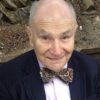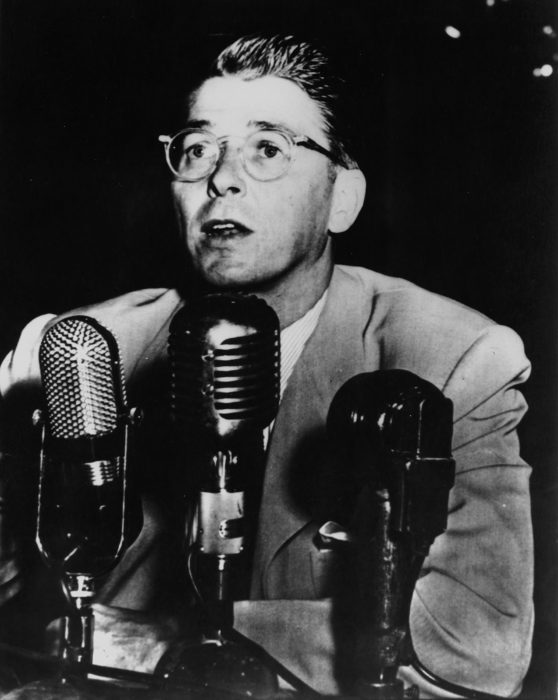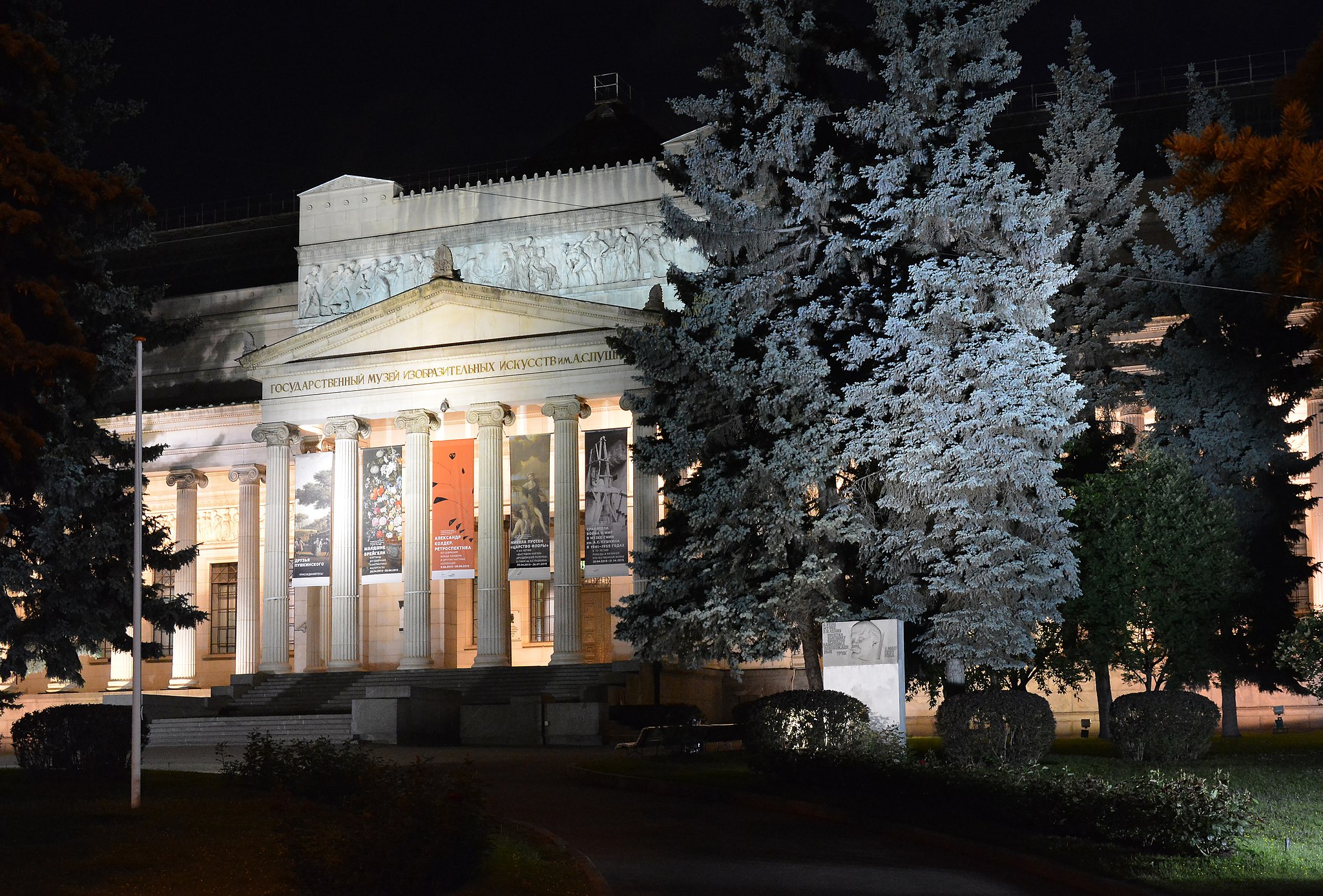Thomas Haines, in this excerpt from his new book, recalls how advice from a civil liberties lawyer saved him from entrapment during the Cold War.
By Thomas Haines
 As a student at the City College of New York in the 1950s, I worked as a live-in babysitter with the family of Jay Gorney, a popular songwriter. He and many of his film industry colleagues had been forced to leave Hollywood for New York when Ronald Reagan named names of “Communists” to the FBI. He had then been fired from a contract at CBS-TV for refusing to answer questions before the House Un-American Activities Committee. While I lived with the Gorneys, we knew that the FBI would pick through any papers we threw in the trash. Taking precautions was part of our normal routine. We weren’t surprised to hear clicks on the phone because the FBI was tapping everyone’s phones. In those days, they weren’t surreptitious.
As a student at the City College of New York in the 1950s, I worked as a live-in babysitter with the family of Jay Gorney, a popular songwriter. He and many of his film industry colleagues had been forced to leave Hollywood for New York when Ronald Reagan named names of “Communists” to the FBI. He had then been fired from a contract at CBS-TV for refusing to answer questions before the House Un-American Activities Committee. While I lived with the Gorneys, we knew that the FBI would pick through any papers we threw in the trash. Taking precautions was part of our normal routine. We weren’t surprised to hear clicks on the phone because the FBI was tapping everyone’s phones. In those days, they weren’t surreptitious.

Ronald Reagan testifying at House Un-American Activities Committee in Washington. D.C., 1947. (White House Photographic Collection)
Almost 20 years later, in the summer of 1970, my wife Adrienne and I visited the Soviet Union. She was a successful artist; her Russian-born mother, working with the Soviet embassy in Washington, had helped arrange a show for her at the Pushkin Museum in Moscow. When we got to Moscow, we found that the curator of the Pushkin knew nothing about any show, which never happened, for reasons I never understood. But I had the opportunity to meet some of my Russian scientific colleagues.
Next, Adrienne and I went for a six-month sabbatical at The University of California Berkeley.
In April 1971, shortly after we returned to New York from Berkeley, I received an 8:00 a.m. phone call from an FBI agent.
“Dr. Haines?” he began, “I need you to meet with me at our office on Third Avenue.”
“About what?” I asked.
“You’ll see when you get here.”
“I don’t understand.” I said. “You can’t tell me what it is and I’ll find out when I get there? Why is that? I’m very busy and I’m not going to come in unless I know what it’s about.” The agent got very pushy, insisting that I meet with him.
“Look, if I come meet with you, are we going to be alone?”
“Well, no,” he said. “Agent So-and-so will also be there.”
“There’s two of you and one of me, and I’m not comfortable with that. Give me twenty-four hours to think about it.”
Wise Counsel
As soon as I hung up, I called an attorney friend who specialized in civil liberties cases. He explained to me that the two FBI agents were lawyers, and that I needed to be careful not to let them get me in a position where they could accuse me of perjury, because then they’d have the leverage to force me to work for them as a spy.
“It happens all the time,” the lawyer said. “You need to bring a witness. Say that you would like your lawyer to be present, and they’ll refuse. When you ask why, they’ll say, ‘There’s no reason for you to have a lawyer. Surely, you’re not protecting yourself against the U.S. government.’”
I asked if the witness had to be a lawyer, or could it be a professor in my department? He said a colleague was fine, and added, “They won’t meet with you, because they don’t want a witness.” Neil McKelvey was a close friend on the chemistry faculty at CCNY and a brilliant chess player known to play simultaneous chess with 14 students at once. He agreed to be my witness.
The next morning at 8:00, the FBI agent called, and our conversation unfolded exactly as the lawyer had predicted. We went round and round for a while. When I asked to bring a witness, the agent demanded, “Why do you need a witness, just to talk to the FBI?” I said, “I guess I read TheNew York Times.”
He immediately hung up, and that was that. There wasn’t going to be any meeting with the FBI. I forgot all about it until later that year I received a call from someone in the State Department who wanted to know how it came about that Adrienne had been offered a show at the Pushkin Museum. I gave him the name of the man at the Soviet embassy who had originally contacted us in 1969. Only then did it dawn on me that the FBI’s phone call was connected with Adrienne’s proposed show.
I shouldn’t have been surprised that the FBI called. I had been politically active ever since living with the Gorneys. I had even been on Nixon’s “Enemies List.” But my mother-in-law’s Russian connection and our trip to the Soviet Union were the catalyst. It turned out that for two years, beginning June 3, 1969, and ending April 22, 1971, the FBI had been building a file on me.

Pushkin Museum of Fine Arts in 2015. (Andrey Korzun, CC BY-SA 4.0, Wikimedia Commons)
Enter Alger Hiss
I found out in 1975, through a coincidence. At a dinner after a funeral — I can’t recall whose — I was astonished to find myself sitting next to Alger Hiss, who had been accused of spying for the Soviets.
Hiss’s highly publicized trial set off Sen. Joe McCarthy’s anti-Communist reign of terror, and helped put Richard Nixon on the map. Though not indicted for espionage, Hiss was found guilty of perjury and sentenced to five years in prison, and was released a year early, in 1954. Disbarred from practicing law and unable to find other employment, Hiss worked as a salesman for the stationery company S. Novick in New York City. It was awful to think of him going door-to-door selling pencils. When I met him, he was still working to prove his innocence. He seemed beaten down.
We started talking, and I told him I’d had a bizarre experience with the FBI. “What was that?” he asked. I told him about the FBI’s phone calls, our trip to Moscow, and Adrienne’s proposed exhibition at the Pushkin that never materialized. “The FBI must have a file on you or they wouldn’t have called you like that. They must have wanted to get you to spy on Soviet scientists,” he said, confirming my lawyer’s warning. Hiss advised me to request my FBI file through the Freedom of Information Act.
 I sent a first request on Nov. 4, 1975; nearly a year later, on Oct. 1, 1976, the FBI responded with a letter demanding 10 cents a page for 40 pages. I mailed them a check for $4 and they sent me a receipt, and we went back and forth some more.
I sent a first request on Nov. 4, 1975; nearly a year later, on Oct. 1, 1976, the FBI responded with a letter demanding 10 cents a page for 40 pages. I mailed them a check for $4 and they sent me a receipt, and we went back and forth some more.
Finally, on Dec. 19, 1977, two years after my first request, I received a 48 -page packet. It contained information about my employment, education, marriage, and other aspects of my life, as well as biographical details on Adrienne and her mother. Many lines and some complete pages were blacked out. The file also brimmed with ludicrous misinformation: wrong addresses, misspelled names (including my own), and — before my daughter Avril was born — it listed me as having three children: “Larry and Bobby” (Adrienne’s first cousin and his wife), and “Luco” — the nickname of our poodle, Leukocyte.
Obviously, the FBI had spotted these names while illegally reading our mail, and had assumed they referred to children. Earlier in 1977, a New York Times article had reported that the ACLU won a suit against the U.S, government for illegally opening “at least 215,000 pieces of mail” from 1953-1973. The people being spied upon were academics like myself who had had incidental contact with the Soviet Union.
Horrifying and Hilarious
The file was horrifying as well as hilarious. I gasped when I read the following: “Information from Bureau informant 200, a most sensitive and reliable source, has revealed that Adrienne Haines is to receive a special invitation from the Friendship Society of the Institute of Soviet-American Relations, Moscow, USSR … in connection with an exhibition of her paintings at the White Hall (Pushkin Arts) Museum.” The page below, dated June 3, 1969, included a hand-written note in the upper right possibly referring to informant 200, and apparently indicating that release of the document had been cleared by the CIA on 10-4-77. Who on earth could be this “informant 200, a most sensitive and reliable source”? How very creepy that someone Adrienne and I knew was providing information about us to the FBI.
Each memo in my file was marked “TO: Director.” The Director, of course, was J. Edgar Hoover, who led the FBI from 1924 until his death in May 1972. Hoover was a master at spying on leaders like Martin Luther King Jr. and then blackmailing them. He especially pursued gays, even though he himself was probably a closeted homosexual. In my opinion, he was absolutely evil.
Even while the FBI pretends to protect us from crime, its entrapment tactics put it on a level with the Mafia. “Lying to the FBI” can bring down the innocent, the guilty, and the highflying. Media mogul Martha Stewart went to jail in 2005, not for selling a failing stock on her broker’s advice, but for allegedly lying to the FBI about it. George Papadopoulos, a former foreign policy adviser for candidate Donald Trump, cooperated in the investigation of allegedRussian involvement in the campaign under threat of prosecution for “lying to the FBI.” I can never forget what they did to Alger Hiss. What a lucky escape I’d had. By insisting on bringing a witness, I had avoided being interviewed.
My FBI file ended with a two-page summary of FBI conversations with me in April 1971, concluding, “In views of HAINES’ intimidating statement about ‘The New York Times’ account of Bureau activities and his potential for causing embarrassment to the Bureau, it is not deemed advisable to further contact HAINES and this case is being closed.”
Adapted from “A Curious Life: From Rebel Orphan to Innovative Scientist,” by Thomas H. Haines with Mindy Lewis, Post Hill Press Paperback, August, 2019.
Before commenting please read Robert Parry’s Comment Policy. Allegations unsupported by facts, gross or misleading factual errors and ad hominem attacks, and abusive language toward other commenters or our writers will be removed. If your comment does not immediately appear, please be patient as it is manually reviewed.

“Hoover was a master at spying on leaders like Martin Luther King Jr. and then blackmailing them.”
There is a lot more to it than that because the FBI tried to persuade MLK to kill himself.
The assassination of MLK may have been an FBI operation:
https://www.skyhorsepublishing.com/9781510729629/the-plot-to-kill-king/
Having been the subject of FBI investigations when applying for Conscientious Object to War status, I can attest that FBI reports are a collection of unchecked information, mostly from interviews, including rumor and speculation, from people down the street, or co-workers of relatives, etc. who may not even know the subject. The the govt. may use the report to show the subject was “named as a (fill in the crime)” and used to harm the subjects reputation, cause him/her to lose their job, etc. This is how McCarthy era Witch Hunts were carried out.
This story is a word to the wise though.
So much for the FBI pursuing “Truth Justice and the American Way.”
Alger Hiss was convicted of perjury for denying that his relationship with Whittaker Chambers was anything but distant, a denial which seemed to be inconsistent with Chambers’ knowledge of personal details about Hiss, details which only close personal acquaintance–or a bugged telephone–would make possible.
The FBI mailed me a box of numerous illegal drugs and then actually got a judge to sign a “search warrant” for those drugs in my house. Fortunately, I refused the box of drugs from a thoroughly incompetent FBI agent disguised as a “mailman”. Unfortunately, they spent eight hours taking my house apart looking for the drugs I DID NOT possess.
The piss-off was I would have co-operated with them had they asked, but setting me up to go to prison, I had no recourse but to ridicule them. They still won’t release my file.
The lack of accountability when it comes to how the government behaves seems to be a tradition in this country rather than a recent development. Thank you for this article.
Thank that lawyer!
Just like in Michael Flynn’s ambush interview, where FBI Agent Peter Strzok did the questioning and FBI Agent Joe Pientka took notes:
“McCabe, by his own account, urged Flynn to talk to the agents alone, without a lawyer present.
“. . . the agents said Flynn was ‘relaxed and jocular’ and offered the agents ‘a little tour’ of his part of the White House.
“. . . before the interview, McCabe and other FBI officials ‘decided the agents would not warn Flynn that it was a crime to lie during an FBI interview because they wanted Flynn to be relaxed . . .’”
Memo: FBI recommended Michael Flynn not have lawyer present during interview, did not warn of false statement consequences
https://www.washingtonexaminer.com/news/memo-fbi-recommended-michael-flynn-not-have-lawyer-present-during-interview-did-not-warn-of-false-statement-consequences
It’s likely, as some suggest, that — in addition to the Russiagate set-up — Flynn was also targeted for telling the truth, in effect revealing that the War on Terror was in reality the War for Terror:
Mehdi Hasan: Let me – let me just to, before we move on, just to clarify once more, you are basically saying that even in government at the time, you knew those groups were around. You saw this analysis –
Michael Flynn: Sure.
Mehdi Hasan: – and you were arguing against it. But who wasn’t listening?
Michael Flynn: I think the administration.
Mehdi Hasan: So the administration turned a blind eye to your analysis –
Michael Flynn: I don’t know if they turned a blind eye. I think it was a decision. I think it was a wilful decision.
Mehdi Hasan: A wilful decision to go – support an insurgency that had Salafist, al-Qaeda and Muslim Brotherhood?
Michael Flynn: Well, a wilful decision to do what they’re doing, . . .
Video and Full Transcript: Michael Flynn on ISIS/ISIL | Al Jazeera, 13 Jan 2016
https://www.aljazeera.com/programmes/headtohead/2016/01/transcript-michael-flynn-160104174144334.html
jmg
Max Blumenthal’s “Management of Savagery”, is a brilliant expose’ of what actually happened to create what you refer to as the “War for Terror”.
In my humble opinion his effort drops off significantly toward the end of the book but the book is a must read if you do not
understand how this war for terror worked. His work here dove tails nicely with Bob Baers book “Sleeping With the Devil”. Baers
book is not noted and Max’s book could be noted better but in the end the message comes through loud and clear. Many many of
the names appear in both books connected to the same story lines.
Baers book displays a copy right to a map 2001 and Baer’s book was released in 2003. Bob was pretty upset with Bill Clinton and CIA and I think he left the service about this time. Yes Baer is ex-CIA.
The problems in the middle east are the result of the struggle for control, not so much control of oil but control of money and power by the elite. The same people who control our government.
As for Flynn, who the hell knows he may have been placed in order to disrupt. We don’t see any documents they all seem to be lying and until I see proof there is no pudding!
But the blackmail aspect is real truth. Facts exist and the ruling elite are shaking in there boots about this Epstein debacle. We need to know exactly what happened during his entire life and we need to know yesterday.
Black mail for control of individuals and money laundering to buy everything else needed for world domination! But you must remember this is not a short story but covers decades.
Go see Whitney Webb’s “From Spook Air to the Lolita Express, the Genisis and Evolution of the Jeffery Epstein, Bill Clinton Relationship https://mintpressnews.com/genisis-jeffery-epstein-bill-clinton-relationship/261455
Hint! Bill Barr was instrumental to Clinton’s life just as he was instrumental to GHWB 41.
Yet further proof we are a police state.